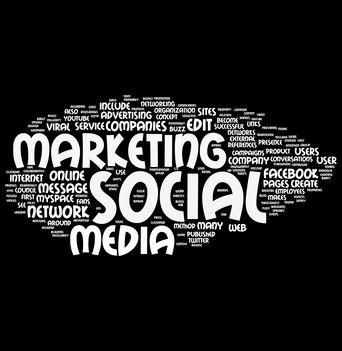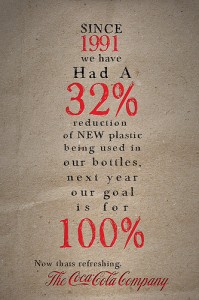I discovered an amazing blog- Environz that connects sustainability to business, and I chose the post “Designer’s Toolkit: From Planned Obsolescence to Design for Environment(DfE)-II: C2C”. This blogpost effectively shows the many options that businesses can approach in order to reach a more sustainable level. It uses examples of companies that belong to different industries but adopt similar ways to make their products more environment-friendly. The eco-friendly system of Coke and Patagonia is an example of a collaboration of two companies, where coke bottles are recycled to make Patagonia clothing products. The blog also mentions the responsibility of company that carries on after the product is sold till the product’s disposal- “Extraction, Processing, Manufacturing, Distribution, Consumption and Disposal”. Corporate Social responsibility is defined by innovation towards the social and environmental betterment, and companies such as CoCa Cola are doing that through it’s focus on not just the “making” of a product but also its disposal. I think as sustainability becomes more and more prominent in marketing, companies will have to find similar ways to surpass the competition.
Pasha Sadri and Jess Lee’s POLYVORE
 Polyvore is the first business that came to mind as soon as I read the definitions of an entrepreneur. Polyvore is an online “social shopping” company, a website where users can put together fashion looks by collaborating pictures from magazines, newspapers, fashion blogs, and online fashion stores. But, unlike other “fashionista” websites, Polyvore offers a social aspect to their followers. For example, a fashion look created on Polyvore can be posted on Facebook and twitter, with tagged prices and sources. This gives the user more power in the online fashion world and a sense of community. Polyvore is an entrepreneurship because:
Polyvore is the first business that came to mind as soon as I read the definitions of an entrepreneur. Polyvore is an online “social shopping” company, a website where users can put together fashion looks by collaborating pictures from magazines, newspapers, fashion blogs, and online fashion stores. But, unlike other “fashionista” websites, Polyvore offers a social aspect to their followers. For example, a fashion look created on Polyvore can be posted on Facebook and twitter, with tagged prices and sources. This gives the user more power in the online fashion world and a sense of community. Polyvore is an entrepreneurship because:
–Amount of wealth: Polyvore already has pocketed partnerships with big fashion brands such as Amercian Eagle.
–Spread of wealth: Polyvore definitely has potential of fast growth in wealth in a short period of time because online social businesses often succeed faster.
–Risk: Polyvore highly depends on innovation and consumer choice, which exposes it to the risk of future competition and social popularity.
–Innovation: Polyvore is definitely innovative with its new collaboration of a marketing aspect and social aspect in the world of fashion.
Marketing Research on another level
I was fascinated by the use of internet to predict consumer behaviours and trends, but i cannot imagine a scientific technology to further narrow down a company’s research. I read Johnson Kim’s post “Marketing: Cultural, Social, Personal, and now Neuroscience” and realized that it would change the way marketing works in the business world right now. Would this change be good or bad, expensive or inexpensive and many other questions came up as soon as i read the article. This neuroscience technology analyzes the “passion centre” of a human brain, which is the part that influences decisions based on emotion and little logic. Well, what could be better for marketers than to know what kind of advertisement stimulates the passion centre? While this technology targets a consumer’s mind directly, the possibility of such research would change the process of a company’s marketing team. The strategies for “brand-positioning” and “customer satisfaction” that we’ve developed over the years would have to change, hence complicating things. Also, I don’t think people would ethically allow such technology to “invade” their minds because a person’s thought process is meant to be private.
I chose to elaborate on a post from Josh Favel’s Comm 101 blog. He uses the example of Nalgene, a famous water-bottle company to explain the effect of consumer perception on the sales of even a well-established brand. I can relate this to my post on Steve Jobs and his quote “As we have tried to come up with a strategy and a vision for Apple. It started with what incredible benefits can we give to the customer, where can we take the customer…” Now, Nalgene has applied the same strategy, the brand would has identified the growing trend of health safety and environment preservation. Even though, Nalgene is a plastic bottle company, it markets the brand in way that consumers feel that their needs or benefits are being fulfilled. I think that the company is on the right path of brand positioning and marketing. To manipulate a consumer’s view of plastic as toxic, Nalgene prints a “BPA free” sticker on the bottles, making people think that it’s not toxic even though there are still other very unhealthy chemicals related to plastic. Also, Nalgene has smartly devoted a good part of their website to “responsibility”. Is it a clever technique?
I’ve noticed many blog postings related to The Great Steve Jobs, So I did some research and chose a video from 1997, because I wanted to note what kind of ideas Steve Jobs had then, that we learn now.

1. Brand Positioning: “As we have tried to come up with a strategy and a vision for Apple. It started with what incredible benefits can we give to the customer, where can we take the customer…” I remember Elaine emphasized on this exact point because that’s what changes a company to a brand, for customer to be able to see WHY that brand is suitable for them.
2. “You have gotta’ start with the customer experience and work backwards to the technology. You can’t start with the technology and try to figure out where you’re gonna’ try to sell it.” I think this relates to the another great strategy (Dell), because Dell’s primary focus was the “need of customer” (customization) rather than selling technology.
I’d like to end on this inspiring quote because it’s applicable to any situation in our lives, “Some mistakes will be made along the way, but that’s good, because at least some decisions are being made.“
 The growing mobile market in B.C. is a great example of the impact of competition on a highly limited market. In B.C., I remember my father paying $130 for 3 cellphones with minimal features. This was a family package offered by Rogers in 2008 and it was interesting to note the effects of the addition of new cellphone companies starting december 2009. Now, “the big 3” (Rogers, Telus & Bell) have to compete for new sales as well struggle to keep thecurrent customers.I chose this article because it briefly summarizes how important finance and marketing becomes during times of a highly competitive market. While, the new mobile companies have an advantage of low prices in comparison to the “big 3”, the older companies have the advantage of lower costs due to their already established businesses. While these companies struggle to make profits, British Columbians enjoy the benefits of new, “attractive” deals that remind us of the sales during Christmas season. Its almost like a sweet revenge, rather than companies exploiting the power of limited options, now consumers get to exploit the power of numerous alternatives.
The growing mobile market in B.C. is a great example of the impact of competition on a highly limited market. In B.C., I remember my father paying $130 for 3 cellphones with minimal features. This was a family package offered by Rogers in 2008 and it was interesting to note the effects of the addition of new cellphone companies starting december 2009. Now, “the big 3” (Rogers, Telus & Bell) have to compete for new sales as well struggle to keep thecurrent customers.I chose this article because it briefly summarizes how important finance and marketing becomes during times of a highly competitive market. While, the new mobile companies have an advantage of low prices in comparison to the “big 3”, the older companies have the advantage of lower costs due to their already established businesses. While these companies struggle to make profits, British Columbians enjoy the benefits of new, “attractive” deals that remind us of the sales during Christmas season. Its almost like a sweet revenge, rather than companies exploiting the power of limited options, now consumers get to exploit the power of numerous alternatives.
I remember discussing Scotiabank’s expansion into China in our lecture; therefore, I found it noteworthy to see Scotiabank in the news yet again. This time, the company is buying 51% stake in Colombia’s Banco Colpatria. ScotiaBank had been part of the Latin American market for 6 years, so why has it decided to buy such a huge share in a Colombian bank now? Well, the answer is quite obvious, while the economy is on a downturn; it is actually an opportunity for stable businesses to invest for the future. I think this is great strategic move in order to establish a global market for Scotiabank because it keeps the business “safe” in developed economies and grows the business in developing economies. I also believe that Colombia is a better option because it has less strict government control in comparison to China. Before Scotiabank made this decision, the company must have gone through a process of analyzing the issue, recognizing the opportunity, weighing the risks, calculating a break-even analysis, etc. So, I connected this decision to our case studies and finally realized how our knowledge will be applicable in the future.
Article: “Scotiabank to buy 51 per cent stake in Colombian bank for $1B“

I’m sure I’m not the only YouTube viewer who finds the pre-roll ads extremely annoying and time consuming, but now I have different view as a Comm 101 student. After watching the video linked to this article, I realized the importance of those advertisements for YouTube. Like all businesses, YouTube is also a company trying to expand and establish itself in the social media market while competing with the television network. I think YouTube has a huge jumpstart compared to many of the advertising rivals because of its new and trendy image and also because of its ability to target an audience individually with every video that is viewed. While companies such as the shopping network HSN and Xbox games, are pursuing the aspect of convenient shopping, YouTube already has a set market where advertisers can link their ads to their websites. I think this is highly advantageous because it is more easy for people to click and buy rather than watch an ad on television and then go online to refer to the website. Basically, I chose this article because it showed the potential of growth that those “annoying” ads offer YouTube and its users.


[Personal + Creative= Ingenious]
Maybe my equation is a little exaggerating, but I think Coca Cola’s new marketing experiment is a great idea because it provides a customer with a very clear message- buy our product, its named after you! While, this can be called the brand’s new “point of difference”, it can also be considered their most impending marketing tool. Business is often focused around customers because they are the buyers and the promoters of the product. Coca Cola’s goal is to create a trend and a community with their brand. While the marketing director says “it is all about connecting people, mainly in the real world, but also digitally as well”, the notion of ‘bringing people together’ and stirring conversations between strangers, is promoting their product all along. Also, by using social networks such as Facebook, YouTube and Twitter, Coca Cola appeals to the new generation and presents itself as a company that constantly innovates. I think this gives the consumers a great combination of individuality and community. So, why is Coca Cola “experimenting” this campaign rather than releasing it worldwide?
“Coke’s $5m summer marketing blitz gets personal”


